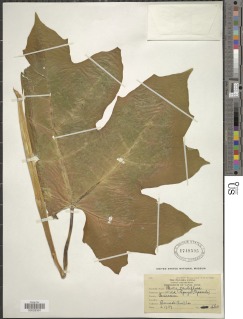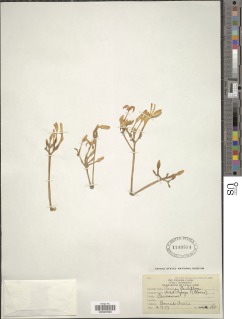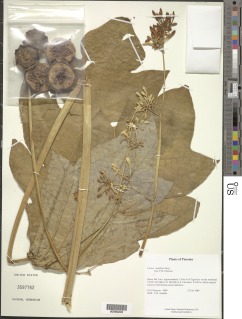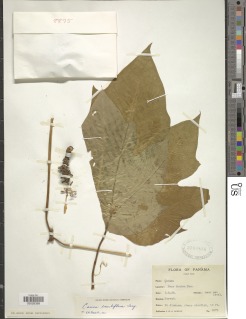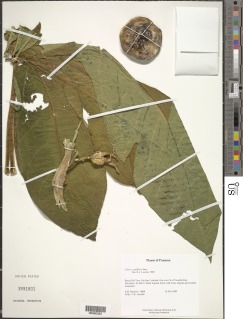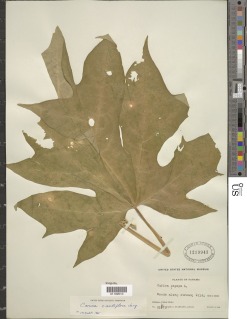

|
|
|
|
Family: Caricaceae
papaya, more...papaya (es: Papayito tapaculo)
[Carica cauliflora Jacq., moreCarica pennata Heilborn] |
Description: A small treelet, with a single, straight, unbranched trunk, and large, highly lobed leaves. The trunk is covered with scars where previous leaves have been shed. Reproduction: Dioecious. Males produce white flowers on long stalks out of the trunk, near the leaves. Female flowers are on shorter stalks. Fruits are large, green. Distribution: Only in open areas and forest edge, rare in the Canal area. Similar Species: This is not the same as the cultivated papaya, LK caripa C. papaya, LK2 but is very similar. No other tree or shrub has such convoluted leaves. Some epiphytic Araceae have somewhat similar leaves. Uses: The fruit is not edible. Descripción: Árboles o arbustos de 3-6 m de alto. Tallos huecos y ligeramente ramificados. El desprendimiento de cualquier parte de la planta produce una savia lechosa. Hojas concentradas en el ápice del tronco, alcanzan hasta 50 cm de diámetro, palmatilobuladas, con cinco lóbulos, ápices de los lóbulos acuminados. Flores blancas. Fruto solitario, ovoides, elipsoidales o casi esféricos, alcanzan hasta 7 cm de largo y 4 cm de ancho, verdes, tornándose amarillos al madurar. Datos Ecológicos: La especie crece a bajas y medianas elevaciones, en bosques húmedos o muy húmedo algunas veces en bosques secos a orillas de ríos. En Panamá se encuentra en las provincias de Colón, Darién, Panamá y Veraguas. Florece y fructifica de marzo a julio. Especies Parecidas: A menudo se confunde con LK caripa Carica papaya LK2 , pero en C. papaya el fruto no es solitario. Usos: La pulpa de los frutos maduros es ácida y no conviene para comer cruda, pero se puede cocinar con azúcar para producir dulces y mermeladas. Nunca deben tragarse las semillas porque pueden ocasionar obstrucciones intestinales. Unbranched dioecious tree, 3-6 m tall, to 10 cm dbh, mostly glabrous. Leaves in a dense terminal crown; petioles mostly more than 50 cm long, hollow, with slightly milky sap; blades ovate, shallowly 5-lobed when mature, cordate, 30-70 cm long, the lobes acute at apex, often broadly incised; palmate veins at base 5. Staminate inflorescences dichotomously branched, ca 30 cm long; pedicels very short; flowers many, ca 3 cm long; calyx deeply 5-lobed, ca 1.5 mm long, green; corolla light yellow, 5-lobed, the lobes spreading, linear-oblong, 12-20 mm long; anthers 10, nearly sessile, linear-spatulate, to 4 mm long. Pistillate inflorescences contracted, ca 7-flowered, 2.5-5 cm long; calyx lobes ca 2 mm long; corolla 5-lobed to base, ca 2.5 cm long, white or yellowish, the apices reddish; ovary glabrous; style ca 3 mm long; stigmas 5, linear, ca 1 cm long. Fruits maturing well below leaves, sometimes near base of trunk, borne on thick warty protuberances, the fruiting pedicels to 5 cm long and 8 mm diam; berries obovate, ca 8 cm long and 6 cm wide, minutely apiculate, becoming orange; exocarp to 7 mm thick, forming whitish droplets when cut; mesocarp sweet, pithy, white to translucent, with aroma of fresh grapes; seeds many, ovate, 10-12 mm long, the ridges 5 or 6, deep, corky. Foster 1394. Rare; collected once by Aviles and once by Foster near the shore between the ends of Zetek and Armour trails. Flowers in the dry season (February and March). Some fruits have been seen in June and November. |


